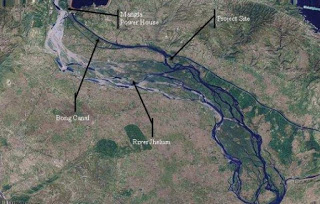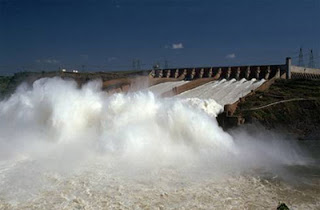The Project is a low head hydropower scheme and is strictly run-of-the-river without any storage or new reservoir. The Mangla reservoir, dam and 1000 MW power house, constructed in the early sixties feeds the Project downstream of the Mangla powerhouse, through its tailrace channel. The main purpose of the project activity is to generate electricity for supply to the national grid using clean, renewable and sustainable natural resources and tapping the significant hydropower potential in the country.
The project activity represents development of the first hydropower independent power producer in Pakistan and is expected to act as a catalyst for hydropower development in the country and open the way for private investment in this vital sector. The power generated will be sold, through a 25 year power purchase agreement, to the Government owned National Transmission and Despatch Company Limited (NTDC).
 |
| Location of Project |
Despite the large hydropower potential, Pakistan’s grid is predominantly hydrocarbon intensive. Due to looming power shortages and increasing demand/supply gap expected from 2007 and onwards at a rate of some 1,000 MW per annum planners are forced turn once again to “quick fix” thermal generation to mitigate the significant power shortages expected.
The Project will contribute clean and renewable hydroelectricity to the deficient national power resources and contribute to GHG emission reduction by displacing the electricity production requirement of fossil fuel-fired power plants to the extent of its generation. The interconnection is close to the load centre and it is expected that new plant will result in reduction of some 4.572 million tons of CO2e emissions over the crediting period of 21 years.
The Project is located 7.5 km downstream of Mangla Dam some 120 km southeast of Islamabad, capital city of Pakistan. The Mangla dam and reservoir were constructed some 40 years ago, with support of the World Bank under the Indus Basin Treaty to impound and store the water of the River Jhelum for irrigation use and incidental power generation. The Project site is easily accessible from the main highway by good metalled roads requirement for new infrastructure is minimal.
The key components of the Project include intake, headrace channel, powerhouse complex, tailrace channel, switchyard, interconnection facility, road-bridge and subsidiary outfall structure.
The switchyard will provide connectivity with the double circuit in-out arrangement with the two existing 132 kV Mangla-Kharian transmission lines pass over the Project Site and connected to the grid system.
All the power generated by the Project will be sold to the National Transmission and Despatch Company (NTDC) under a long term power purchase agreement with a 25 year term.
The project achieved financial closing on December 20, 2009. US dollar financing has been provided by Asian Development Bank (ADB),
Like Us on Facebook!
Islamic Development Bank, International Finance Corporation, and the French origin Société de Promotion et de Participation pour la Coopération Economique (“PROPARCO”) whereas Pak rupee financing has been provided by Habib Bank Limited (HBL) and National Bank of Pakistan (NBP).
Subscribe Us on YouTube!
Laraib Energy Limited (Laraib) is the owner and developer of the ‘New Bong Escape’ Hydroelectric Power Project. This was told to a group of journalists, who are in ADB Press Tour on different developmental projects relating to water and power in different parts of the country.
Laraib is a subsidiary of Hub Power Company Limited (HUBCO) which owns 75 percent of shares of the company. HUBCO is the owner of 1,292 MW Hub Power Station, which is the first and largest power station to have been financed by the private sector in Southern Asia during the 1990s and one of the largest private power projects in the newly industrialized world at that time. The balance 25 percent shares are held by the minority shareholders.
















